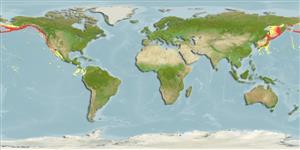>
Perciformes/Scorpaenoidei (Scorpionfishes) >
Sebastidae (Rockfishes, rockcods and thornyheads) > Sebastolobinae
Etymology: Sebastolobus: Greek, sebastes = august, venerable + Greek, lobos = lobe (Ref. 45335); alascanus: Species name after Alaska, the type locality (Ref. 27436).
More on author: Bean.
Environment: milieu / climate zone / depth range / distribution range
Écologie
marin démersal; profondeur 17 - 1600 m (Ref. 50550), usually 91 - ? m (Ref. 2850). Temperate
North Pacific: Sea of Okhotsk north to the Navarin Canyon in the Bering Sea and from Stalemate Bank and Ulm Plateau in the Aleutian Islands southeast to Cedros Island, Baja California, Mexico. Reported from Japan (Ref. 559).
Length at first maturity / Taille / Poids / Âge
Maturity: Lm 22.0 range ? - ? cm
Max length : 80.0 cm SL mâle / non sexé; (Ref. 559); poids max. publié: 9.0 kg (Ref. 56527); âge max. reporté: 100 années (Ref. 90032)
Épines dorsales (Total): 15 - 17; Rayons mous dorsaux (Total): 8-9; Épines anales 3; Rayons mous anaux: 4 - 5. Head spines very strong - nasal, preocular, supraocular, postocular, tympanic, parietal and nuchal spines present, coronal spines absent; large head and elongate body; strong spiny ridge on head; 3rd dorsal spine not much longer than 2nd, 4th or 5th; strong notch on pectoral fin (Ref. 27437). Bright red with some black on fins; gill chamber mostly pale (Ref. 27437). Caudal slightly rounded (Ref. 6885).
Very common on soft bottoms (Ref. 2850). Oviparous (Ref. 205). Eggs are extruded in floating gelatinous masses (Ref. 31279). Have a thick glandular tissue on posterior margin of fin spines which is believed to be venomous (Ref. 57406). Rarely taken by game fishers (Ref. 27436). Flesh sweeter than that of other rockfishes (Ref. 27436).
Unlike other representatives of this group, this species has internal fertilization Oviparous (Ref. 6885). Females possess specialized ovarian structures including stalk-like ovigerous lamellae and secretory epithelia (Ref. 32832).
Eschmeyer, W.N., E.S. Herald and H. Hammann, 1983. A field guide to Pacific coast fishes of North America. Boston (MA, USA): Houghton Mifflin Company. xii+336 p. (Ref. 2850)
Statut dans la liste rouge de l'IUCN (Ref. 130435)
Utilisations par l'homme
Pêcheries: intérêt commercial mineur
Plus d'informations
RéférencesAquacultureProfil d'aquacultureSouchesGénétiqueElectrophoresesHéritabilitéPathologiesTraitementNutrientsMass conversion
CollaborateursImagesStamps, Coins Misc.SonsCiguateraVitesseType de nageSurface branchialeOtolithesCerveauxVision
Outils
Articles particuliers
Télécharger en XML
Sources Internet
Estimates based on models
Preferred temperature (Ref.
123201): 1.2 - 6.7, mean 3.8 °C (based on 417 cells).
Phylogenetic diversity index (Ref.
82804): PD
50 = 0.6250 [Uniqueness, from 0.5 = low to 2.0 = high].
Bayesian length-weight: a=0.00708 (0.00408 - 0.01228), b=3.16 (3.00 - 3.32), in cm total length, based on LWR estimates for this species & (Sub)family-body (Ref.
93245).
Niveau trophique (Ref.
69278): 3.6 ±0.3 se; based on diet studies.
Generation time: 47.8 ( na - na) years. Estimated as median ln(3)/K based on 1
growth studies.
Résilience (Ref.
120179): Très faible, temps minimum de doublement de population supérieur à 14 ans (tmax> 100 (validated age: 62 yrs); tm= 13; Fec > 10,000).
Prior r = 0.02, 95% CL = 0.01 - 0.03, Based on 1 stock assessment.
Fishing Vulnerability (Ref.
59153): High vulnerability (59 of 100).
Climate Vulnerability (Ref.
125649): Moderate vulnerability (38 of 100).
Nutrients (Ref.
124155): Calcium = 18.4 [8.0, 49.9] mg/100g; Iron = 0.287 [0.128, 0.565] mg/100g; Protein = 17.5 [15.8, 19.3] %; Omega3 = 1.01 [0.41, 2.73] g/100g; Selenium = 29.6 [13.0, 73.1] μg/100g; VitaminA = 13.5 [3.9, 44.9] μg/100g; Zinc = 0.518 [0.305, 0.810] mg/100g (wet weight);
